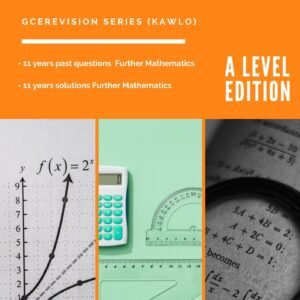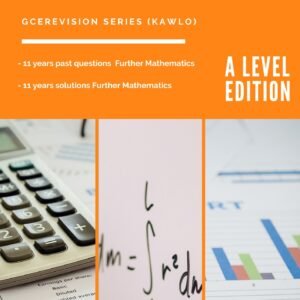Cameroon GCE advanced level June 2025 computer science 2
Cameroon GCE advanced level June 2025 computer science 2
Here are the extracted questions from the provided images, maintaining the original format:
From image_2acf3e.jpg:
- (i) A processor with a machine code instruction format of 16 bits uses 6 of these bits for the op-code and the remaining 10 bits for the operand.
(a) What is the highest memory address that can be addressed by an instruction? (2 marks)
(b) How many different op-codes can this processor have? (2 marks)
(c) Describe the fetch-execute cycle. Explain the use of internal registers in the fetch process. (4 marks)
(ii) In designing a controller for a greenhouse to monitor the irrigation system (I), the window (W), and the heater (H), the table below shows acceptable system combinations.
| I | W | H | Controller |
|—|—|—|————|
| 1 | 1 | 1 | 1 |
| 0 | 0 | 0 | 1 |
| 0 | 1 | 1 | 1 |
| 1 | 0 | 0 | 1 |
| 0 | 1 | 0 | 0 |
| Any other combination | 0 |
Truth table of controller circuit
(a) Use the sum-of-products method to create a Boolean algebra expression from the truth table. (4 marks)
(b) Use Boolean algebra to simplify the expression obtained in 1(ii)(a) above. (5 marks)
(c) Hence, draw a logic circuit for this truth table. (2 marks)
- (i) A floating-point representation uses 5 bits for the mantissa and 3 bits for the exponent, both in two’s complement.
(a) Show how the decimal number -3.5 would be represented in normalised binary form. (4 marks)
(b) Convert the floating-point binary number 011001112 into decimal. (3 marks)
(c) State the effect of each of the following on the floating-point representation of binary numbers:
- decreasing the number of bits allocated to the mantissa
- increasing the number of bits allocated to the exponent (2 marks)
(ii) (a) How many bits are required to address a 4M by 16 main memory if this memory is byte-addressable? (3 marks)
(b) Explain the main difference between sequential access and direct access, and for each, give an example of a storage medium that supports it. (4 marks)
(c) When is random access memory (RAM) said to be dynamic? (1 mark)
- (i) In operating systems, a process is an active entity that changes state.
(a) With the help of a diagram, describe each state in the process state transition diagram and identify which transitions are valid between these states. (6 marks)
(b) What name is given to the data structure that is used to hold the data for the operational state of a process? State any four pieces of information that this data structure holds. (3 marks)
(ii) (a) Explain the terms frame, page, and segment as used in memory management. (3 marks)
(b) Explain the difference between a placement policy and a replacement policy in memory management. (2 marks)
(c) What is virtual memory? How is virtual memory different from cache memory in terms of purpose? (3 marks)
From image_2acf59.jpg:
- An agency wishes to control the booking of live music bands for a number of snack-bars in a given town. Each band when registered in this agency is given a unique name, specific number of musicians, the type of music it plays and its hiring fee. Each band is managed by a manager and a manager may manage several bands. Each manager records his ID card number, name, address and telephone number. Each snack-bar is assigned an ID number, name, address and telephone number. A band is never booked by more than one snack-bar on any particular date.
(i) (a) Explain the terms entity and attribute as used in database modelling. (2 marks)
(b) From the description above, identify FOUR entities for this booking system. Represent each entity using the format:
entity_name (attribute1, attribute2, attribute3,…)
where the key attribute is underlined. (4 marks)
(c) Draw an E-R diagram to show the degree of the relationships that exist between the entities identified above. (4 marks)
(ii) In order to implement a database for the agency, an application developer uses a relational database model.
(a) What is meant by a database model? (2 marks)
(b) Explain the main difference between a relational database and a flat-file database. (2 marks)
(c) State three benefits to the agency of using a relational database. (3 marks)
- (i) The figure below represents a network where S, R, and H represent a switch, a router, and a hub respectively. PC1 to PC5 are personal computers. Study the figure and answer the questions that follow.
(a) Explain the main difference between a switch and a hub. (3 marks)
(b) State and explain the most suitable network architecture that can be used in this network. (3 marks)
(c) PC3 sends a simple broadcast message over the network. Which computers will receive the message sent by PC3? Explain why. (3 marks)
(d) State the layer of the OSI/ISO reference model in which each of the devices switch, router and hub operates. (3 marks)
(ii) (a) Consider the IPv4 address 192.168.8.5. Identify the class of this IP address and state its network identifier and host identifier. (3 marks)
(b) Explain the difference between a MAC address and an IP address? (2 marks)
-
(i) The development of a computer based system is commonly broken down into a number of stages collectively called system development life cycle. Briefly describe the following stages of the system development life cycle: Analysis; Design; Implementation and Testing. (8 marks)
(ii) A programmer has been asked to write a sub program that calculates a person’s age in years from the date of birth and the current date which is taken from the system. The date of birth is given as a parameter in the format dd/mm/yyyy and has already been validated. No person is expected to be over 120 years old. Suggest, giving reasons for your choices:
(a) two values of normal test data. (3 marks)
(b) three values to check a boundary. (4 marks)
(c) one value of erroneous test data. (2 marks)















